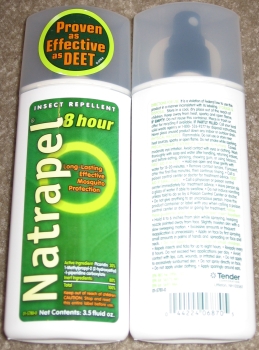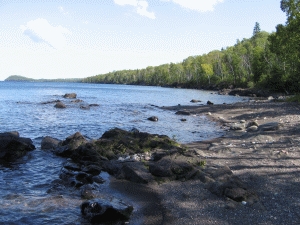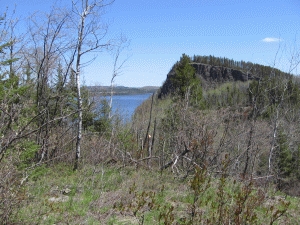Adventure Medical Natrapel Insect
Repellent
Test Series by Kurt Papke
Tester Information
| Name: |
Kurt Papke |
| Age: |
54 |
| Gender: |
Male |
| Height: |
6' 4" (193 cm) |
| Weight: |
220 lb (100 kg) |
| Email address: |
kwpapke at gmail dot com |
| City, State, Country: |
Minneapolis, Minnesota USA |
Backpacking background: mostly in Minnesota - have hiked all of the
Superior
Hiking Trail, starting on the Border Route.
Preferred/typical backpack trip is one week. Dayhiking in
Utah,
Colorado and Oregon. Mostly Spring/Fall seasons.
Comfort-weight hiker: I try to carry as few items as possible, but do
not go to extremes to reduce weight of items carried. I try to do
most of my hiking in seasons where I avoid the worst of the bug
problems and minimize use of insect repellent, but living in Minnesota
mosquitoes are a part of life.
Initial Report
Product Information
| Manufacturer: |
Adventure Medical Kits
|
| Year of manufacture: |
2008 |
Expiration date:
|
Not labeled
|
| Manufacturer website: |
http://www.adventuremedicalkits.com |
| Listed volume (net contents): |
3.5 fl oz (104 ml)
|
| Weight as received: |
4.8 oz (134 g) 4.7 oz (131 g) [2 packages]
|
Package dimensions (measured):
|
6.4 x 2.1 x 1.1 inches (16.2 x
5.2 x 2.7 cm)
|
| MSRP: |
$5.99 US per package
|
Product Description
 Natrapel is packaged in a
tall slender pump spray bottle with a removable cap that protects the
pump from inadvertent dispensing. The active ingredient is
Picaridin, which the product labelling claims is "proven as effective
as DEET" for eight hours of protection. According to the
Wikipedia page on Icaridin (apparently the chemical manufacturers name
for Picaridin) the World Health Organization also claims it
"demonstrates excellent repellent
properties comparable to, and often superior to, those of the standard
DEET". The article also claims Icaridin as opposed to DEET has
less irritation and does not dissolve plastics, both features I would
greatly appreciate if true. Natrapel is packaged in a
tall slender pump spray bottle with a removable cap that protects the
pump from inadvertent dispensing. The active ingredient is
Picaridin, which the product labelling claims is "proven as effective
as DEET" for eight hours of protection. According to the
Wikipedia page on Icaridin (apparently the chemical manufacturers name
for Picaridin) the World Health Organization also claims it
"demonstrates excellent repellent
properties comparable to, and often superior to, those of the standard
DEET". The article also claims Icaridin as opposed to DEET has
less irritation and does not dissolve plastics, both features I would
greatly appreciate if true.
The article claims Icaridin is both colorless and odorless, though a
test spray on the back of my wrist indicated a fresh smell that does
linger. The product label indicates that the contents are 80% inert
ingredients but does not state what those ingredients are.
The labelling claims eight hours of effectiveness and recommends
against more than two applications per day, which should cover a full
hiking day. If I do not achieve eight hours of protection, I will
have to decide whether or not to push the application limit.
Initial Impressions
Packaging: weighing in
at almost 5 oz (140 g) this is more heft for bug dope than I would
ordinarily carry. The bottle fits comfortably in my hand, and the
shape is conducive to use of the pump spray. I was able to use
the pump without any finger contortions or excessive force. The
cap presents quite a bit of resistance to remove - there are mating
ridges on the bottle and cap that keep the cap from falling off, but
also require a fair bit of force to overcome. Replacing the cap
is a bit easier, it easily pops back on. I find the packaging
colors to be pleasant. The bottle is quite large, and would not
fit in many pack hipbelt pockets, nor would I find it comfortable to
carry in pants or shirt pockets.
The "directions for use" on the back of the bottle are somewhat hard to
read. As can be seen from the picture above a very small typeface
is used. I can hardly read the text even with my reading glasses
on. The section headings of the directions are all set in a light green color that has
very poor contrast against the white bottle, making it almost
impossible to read these lines.
Pump spray action: the
pump required three presses to prime. Each finger press produces
a nice fine mist with good dispersion which traveled about 18 inches
(46 cm) in quiet air. I found that by holding the spray head
about 4 inches (10 cm) from my hand [bottle labelling recommends 4-6
inches (10-15 cm)] I could get coverage of an area of about the same
diameter as the distance. Unscrewing the pump head from the
bottle revealed a feed tube that extends to the bottom of the bottle,
so I should be able to utilize the spray for the entire contents as
long as the bottle is held in an upright position.
Fragrance: as
mentioned previously Natrapel has what I would term a "fresh" scent,
reminiscent of eucalyptus. The scent does not disperse quickly.
Skin feel: after
application to the back of my wrist and allowing for time to dry I
could notice a sheen to my skin when held up to a light. Rubbing
a finger over the applied area gave a very faint sticky/oily
sensation. I noticed after doing this that my test fingers also
had a bit of a sticky feel, so apparently there is some dry transfer of
the substance.
Unfortunately from the time the Natrapel arrived to the time of writing
of this initial report the mosquito season had not yet begun, so I was
unable to do any preliminary effectiveness testing.
Test Plan
I have
plans for a week-long May trek through the Boundary Waters (Border
Route
Trail) and a segment of the Superior Hiking Trail (about 120
miles). I will attempt to assess:
- Usability: how easy is it to pack the Natrapel bottle on my
person or pack?
How easy is it to remove the cap and use the pump in the bush?
How easily can I transfer Natrapel sprayed into my hand onto my face
and ears?
- Reliability & robustness: does the pump clog? Does the
spray mechanism continue to work while dispensing the entire contents?
- Functionality: how effective is Natrapel at repelling mosquitoes
and possibly ticks? Hopefully this trip will precede the
notorious black fly season and I will not have the chance to test its
use against them, though the Adventure Medical website claims black fly
effectiveness. Does it really work for eight hours?
- Aesthetics: how do I like the odor after a week of use?
Does it start to become objectionable? Does the odor wash off
from my clothing and sleeping bag after my trip?
- Quantity/sizing: how much of the bottle do I consume on a
one-week trip? Do I run out?
- Adverse effects: is there any irritation from repeated use?
Any burning of the eyes, nose or mouth? Any noticeable
degradation of any of my plastic-based (polyester, nylon, etc.)
clothing?
This concludes my Initial Report on Adventure Medical Natrapel.
Field Report
During the report period I used the Adventure Medical Natrapel during
my
May Boundary Waters trip and also during a month-long Oregon
camping/backpacking journey. Boundary Waters trek: 8-day hike in
Minnesota from the end of the
Gunflint Trail, Magnetic Rock trailhead, along the Border Route to
Grand Portage, then down along the Sawtooth Mountains near the Lake
Superior shoreline on the Superior Hiking Trail to Grand Marais.
The final use was on a 1-week backpacking trip to Isle Royale, Michigan.
Test conditions: several of the days were quite
warm, 75 F (24 C), and several days were quite cold with a low of 23 F
(-5 C). Altitude ranged from sea level along the Oregon Coast to
just under 5000 ft (1500 m) on the slopes of Mount Hood. The
terrain
varied widely, from Minnesota and Michigan lakeshores, Cascade
ridgelines, to the Columbia
River gorge.
One of the notable Natrapel uses on this trek was at this location near
the end of the Border Route:
I stopped at this spot to rest and eat lunch, and it was the first real
insect attack on the trip: pesky flies. I sprayed my face, neck
and hands with Natrapel, and it really did keep them away while I was
eating lunch and resting. On the downside, I had some on my hands
and it managed to get on my tortillas: Natrapel really tastes awful
During the month-long camping excursion to
Oregon in July, most uses were during car camping
or 1-night backpacking trips, though I did use them on some multi-day
backpacking trips to the Wallowa Mountains and to Teddy Roosevelt
National Park in North Dakota. This included several days in the
Columbia River Gorge, 2 days on the Pacific Crest Trail sections near
the Gorge,
several days in the Coastal Range just west of Portland, and several
days on the western slopes of Mount Hood. Temperatures
ranged from a low in the mid-30's F (2 C) in the mountains where I
camped in the snow, to highs in the mid 90's F (35 C) in Teddy
Roosevelt National Park. Since July is peak time for mosquitoes
in Oregon, I had plenty of opportunity to test its effectiveness
against them, and it was up to the task.
 During the
week-long trip to Isle Royale Natrapel was effective at keeping the
mosquitoes from biting in some of the low-lying/swampy areas found on
the island. My hiking partner used it as well and found it
effective and appreciated its pleasant fragrance. At Little Todd Harbor
(picture to the left), the biting flies were quite bad along and near
the beach. The Natrapel had no effect on the flies - they bit
just as much after as before application. Odd that it was
effective against the flies in the Boundary Waters, but not those on
the beach in Isle Royale. During the
week-long trip to Isle Royale Natrapel was effective at keeping the
mosquitoes from biting in some of the low-lying/swampy areas found on
the island. My hiking partner used it as well and found it
effective and appreciated its pleasant fragrance. At Little Todd Harbor
(picture to the left), the biting flies were quite bad along and near
the beach. The Natrapel had no effect on the flies - they bit
just as much after as before application. Odd that it was
effective against the flies in the Boundary Waters, but not those on
the beach in Isle Royale.
It was my experience that the Natrapel would keep mosquitoes from
biting, but did not really keep them completely away from me.
They still
buzzed around, and sometimes lit briefly on my skin, but not long
enough to bite. When I applied the product around lunchtime, I
found I had to re-apply it at dinnertime to be effective, though it
should be noted that I sweat heavily during this test period during the
day, and any repellent might well have been diluted by my sweat levels.
I applied the Natrapel several evenings at dinnertime, and went to bed
with quite a bit still on my arms, neck, face and ankles. I am a
hammock camper, and during warmer weather I use my sleeping bag as a
quilt and lie directly on the silnylon hammock. I detected no
deterioration of the nylon in the areas where my skin contacted the
fabric, nor any residual effects to my nylon hiking pants.
During my Natrapel testing I always applied it using the supplied spray
bottle. I had no problems with the pump spray mechanism, no
clogs. I did notice that as I used up the fluid I had to make
sure I was holding the bottle reasonably upright so the supply tube was
submerged during pumping. This is not a problem when applying to
the arms and facial areas, but can be a bit of a challenge with the
ankles. My typical solution was to spray the repellent into my
palms and then apply it indirectly with my hand to my exposed ankles.
Summary:
Likes:
- Effective against mosquitoes and some types of flies
- Pump spray was easy to use and reliable, no clogging
- Reasonably subtle but pleasant scent - I know I have it on,
but barely
- Unobtrusive skin feel: does not feel oily
- Does not damage plastic camping equipment or clothing
- A little goes a long way - I do not need to bring a large
bottle with you on a hike
Areas for
improvement:
- Fairly large bottle, much more than I would need on a typical
backpacking trip. I could have re-packaged the repellent into
smaller containers, but chose not to
- Eight hour protection claimed might be optimistic
Many thanks to Adventure Medical Kits and BackpackGearTest.org for the
opportunity to
test this product.
Read more reviews of Adventure Medical Kits gear
Read more gear reviews by Kurt Papke
|





 Natrapel is packaged in a
tall slender pump spray bottle with a removable cap that protects the
pump from inadvertent dispensing. The active ingredient is
Picaridin, which the product labelling claims is "proven as effective
as DEET" for eight hours of protection. According to the
Wikipedia page on Icaridin (apparently the chemical manufacturers name
for Picaridin) the World Health Organization also claims it
"demonstrates excellent repellent
properties comparable to, and often superior to, those of the standard
DEET". The article also claims Icaridin as opposed to DEET has
less irritation and does not dissolve plastics, both features I would
greatly appreciate if true.
Natrapel is packaged in a
tall slender pump spray bottle with a removable cap that protects the
pump from inadvertent dispensing. The active ingredient is
Picaridin, which the product labelling claims is "proven as effective
as DEET" for eight hours of protection. According to the
Wikipedia page on Icaridin (apparently the chemical manufacturers name
for Picaridin) the World Health Organization also claims it
"demonstrates excellent repellent
properties comparable to, and often superior to, those of the standard
DEET". The article also claims Icaridin as opposed to DEET has
less irritation and does not dissolve plastics, both features I would
greatly appreciate if true.
 During the
week-long trip to Isle Royale Natrapel was effective at keeping the
mosquitoes from biting in some of the low-lying/swampy areas found on
the island. My hiking partner used it as well and found it
effective and appreciated its pleasant fragrance. At Little Todd Harbor
(picture to the left), the biting flies were quite bad along and near
the beach. The Natrapel had no effect on the flies - they bit
just as much after as before application. Odd that it was
effective against the flies in the Boundary Waters, but not those on
the beach in Isle Royale.
During the
week-long trip to Isle Royale Natrapel was effective at keeping the
mosquitoes from biting in some of the low-lying/swampy areas found on
the island. My hiking partner used it as well and found it
effective and appreciated its pleasant fragrance. At Little Todd Harbor
(picture to the left), the biting flies were quite bad along and near
the beach. The Natrapel had no effect on the flies - they bit
just as much after as before application. Odd that it was
effective against the flies in the Boundary Waters, but not those on
the beach in Isle Royale.